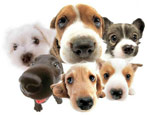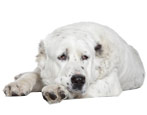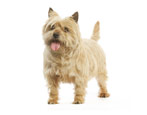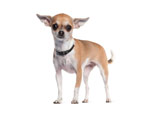How to transfer a dog to dry food?

Every owner wants his dog to eat healthy food. This can be realized either through natural nutrition or using dry food. Each of the methods has its own characteristics.

Advantages and disadvantages
Often, after taking a puppy from the kennel, they begin to feed him natural, believing that it is more useful. In natural food, if, of course, it is not from the common table, there is nothing terrible, it just requires a more careful approach to the preparation of a balanced diet. For example, for small breed puppies, the ratio of Ca to P should be 0.6 to 0.8, and for adults it should be 1 to 1.
An increase or decrease in one leads to poor absorption of the other component, and this is certainly important, especially during the period of changing teeth.

For adult animals a balanced diet is also of great importance, because metabolic disorders can lead to health problems. To normalize metabolic processes in the body, when feeding with natural food, the introduction of vitamins is a prerequisite.
Everyone can make the right diet with due responsibility, but there is a significant disadvantage here - this is the time you spend on choosing products and on everyday cooking. And in the summer, natural food quickly deteriorates, and you will not leave it in the pet's bowl for a long time.

As soon as the owner decided to transfer the pet to a dry diet, he begins to look for all the pros and cons on the Internet.
There is a lot of controversial information on the network about the proper nutrition of dogs, and there are still plenty of reviews about dry food, allegedly it is harmful to the health of the pet. When the famous pediatrician Komarovsky E.O.in one of the broadcasts, they asked if it is harmful for a child to wear diapers, he replied that there is nothing terrible in them, and the diapers were created not for the baby, but for the mother, in order to free her from the daily washing of diapers and to devote more time to herself and her loved ones.
The same can be said for industrial dry dog food. Feeding a four-legged dry food frees the hands of its owner. There is now a very large selection of food for dogs, and all of them are balanced in essential minerals and nutrients. Only depending on the class, these substances can be contained in dry food in different quantities, which can be understood by examining the composition on the back of the package.
Whether or not to introduce food supplements will depend on the degree of absorption of feed... Supplements are usually introduced with economy-class feeds and, less often, premium-class feeds.

At first glance, it seems that when buying ready-made food, food costs increase, but if you recalculate the costs of buying cereals, meat and vitamin and mineral supplements, you can understand that the costs will remain the same, but there will be more free time for walking with your pet. ...
Summarize. Let's start with the pros:
- the correct ratio of proteins, fats, carbohydrates, macro-, microelements and vitamins;
- the composition of the food from the package meets the characteristics of the breed, age and sex group and the constitution of the animal;
- products for prevention, treatment and rehabilitation therapy;
- Dry balls help get rid of dental plaque, which can lead to tartar and gum disease.
- free time appears;
- no need to develop a diet;
- unlike natural, it does not deteriorate for a long time.


Minuses:
- in economy class feeds, the type of protein is not always indicated;
- always monitor the presence of water in the bowl;
- products with a high degree of assimilation are expensive, although at the moment in terms of pricing policy, the issue is controversial.


Industrial food has much more advantages, so the overwhelming majority of owners, realizing this, still decide to transfer their pet to such food. And when you go to a pet store and see a wide variety, many questions immediately arise. Let's consider them.
How to choose the right food?
The main criteria that you need to pay attention to when choosing dry granular food are the composition, pricing policy and the ability to buy it at a nearby pet store. To determine the choice of food, it is necessary to refer to the peculiarities of the composition.
There are different classes of feed.

Economy class
They are ubiquitous and can be purchased at any grocery retailer: Pedigree, Darling, Our Mark and others.
In the composition of about 4% of processed meat products, and the source of protein is often not indicated by the manufacturer in the composition, and the main nutritional value is replenished with cereals, which are introduced in large quantities, beet pulp is a source of fiber. From the analytical composition of the feed, it can be seen that all nutrients and minerals are in the correct ratio and provide the daily requirement of the animal.

But the assimilation of such food is about 60%, the animal will need to eat more food in order to meet all the physiological needs of the body in one or another physiological period. Therefore, with such feeds, it is necessary to add vitamin-mineral complexes or fortified treats to the dog's diet.
Premium class
These are feeds such as Royal Canin, Pro Plan, Hill's, Avba Premium, Brit Premium etc.
The feed uses offal and meat in the amount of 15-30%. The meat ingredient is found in the form of meat flour, feed moisture 10%, or fresh meat, 20% moisture. Due to the higher humidity, the food becomes more flavorful, and this will undoubtedly please the fastidious dogs. Cereals (corn, wheat) and rice add to the overall nutritional value of the feed. The composition takes into account the physiological characteristics: puppies, adults and elderly animals.

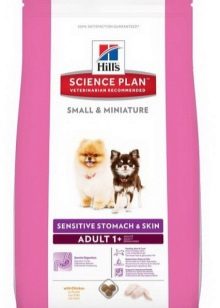

Breed features such as Royal canin there is a whole line of pedigree feeds. And the prevention of various diseases: care for digestion, for skin and wool, for large animals, care for joints, for allergy sufferers, feed on one type of protein. The assimilation of such nutrition is about 80%. It is also necessary to introduce vitamin and mineral supplements, but it is possible less often, mainly in stressful situations or during periods of illness.


Super premium class
Subdivided into super premium and holistic. The first include: 1st Choice, Brit Care, Grandin, Eukanuba and others.
From 40 to 80% of meat, cereals and rice are present in the composition, but in smaller quantities. The absorption of feed is about 92%. Due to the high meat content, the feed is rich in all essential amino acids. In the composition, you can see a huge number of ingredients that also carry the prevention of various diseases. And such useful things as Schiedinger's yucca, which prevents digestive disorders and reduces the odor of feces, the latter property is relevant for owners who do not walk their pets.


Holistics include: Acana, Now Fresh, Abba Holistic, Orijen and the like.
These feeds use high quality ingredients that can be used for human consumption. Meat is plentiful, and grains are replaced by vegetables and fruits. The assimilation of such feeds is up to 96%, the daily rate is lower than that of previous feeds. The use of vitamin and mineral supplements is optional, the feed is fully absorbed by both puppies and adult dogs.
These feeds are very expensive.

Of course, choosing according to the composition is good, but the most important thing is that it suits your pet's taste, and for this, take a small package. And if you decide to take feed by weight, take it only in stores with high traffic, where the feed does not stagnate.
How to translate puppies correctly?
To make the puppy's transition from natural food to industrial food, you need to know a few nuances.
- Having taken a puppy from breeders or from a nursery, it is necessary to clarify its age, find out what was fed, whether vaccination and other treatments were carried out.
- You need to feed the baby for a week or two with the same food as in the nursery. Changing feed, along with a change of environment, can cause serious stress for the animal and health problems.
- If the puppy was not vaccinated in the kennel, and there are plans to do it, then it is better to switch to another food after re-vaccination. Since the vaccination is carried out in the first year of life twice with an interval of 3-4 weeks, the animal is also not recommended to change the diet. Changing feed is a restructuring of the body, and if health problems arise, the vaccine will have to be skipped.


These are the main criteria to be considered. For the rest, babies endure a change of food more often without whims, and a change in diet does not cause difficulties, unlike adults and elderly pets. The method of transferring from natural to dry food is the same as in sexually mature individuals.
How to train an adult dog?
There are many translation methods available on the internet. Unfortunately, not all of them are correct and effective. And the older the animal, the more capricious it perceives the transition. According to the advice of veterinarians, the transfer of the animal must be carried out gradually over 7-10 days by mixing dry food with the dog's usual diet.
This is due primarily to the fact that there are differences in the assimilation of wet and dry food. Natural food has a moisture content of 75-80% and begins to be absorbed already on the tongue, dry food has a moisture content of 10-20%, and in order to start working, they need to get into the stomach. In the stomach, liquid with the enzyme pepsin is added to the food, the food softens, and only after that its assimilation begins. It is necessary to mix the feed in the following proportions (natural food / dry food):
- 1-2 day 75% / 25%;
- 3-4th day 50% / 50%;
- 5-6th day 25% / 75%;
- 7-8th day 15% / 85%.
- 9th and further full daily rate of new nutrition.

In order not to burden the digestive tract, the daily rate must be divided into 3 parts. Each feeding, it is necessary to mix the granules into the porridge, waiting for the dry food to soften, but not completely, and the middle of the granule remains firm. So the new food will give the old food taste and aroma, and the slightly hard granules will help to train the dog to the new food consistency.
It is important to provide the animal with fresh water when switching to dry food. Based on the characteristics of assimilation, the animal will need more liquid when feeding industrial food, so you need to take more bowl under the water. The rate of water consumption is about 50 ml per kilogram of body weight, and when eating dry food - 100 ml per kilogram of animal weight. Ideally, the water should always be fresh, so it is advisable to replace it a couple of times a day.


Possible problems
When making a diet change, you need to clearly understand that this process is long, and you may have to try many feeds before you find a suitable one. Even during a smooth change, various problems can arise.

Allergic reactions
They can be expressed by problems with the skin and hair, as well as digestive problems and sensitive food intolerances.
Solution. In case of allergic reactions and food intolerances, it is necessary to choose a diet on a different type of protein or switch to a prophylactic hypoallergenic food.

To avoid digestive problems, probiotics are introduced at the stage of changing the diet, and if this happens, choose a different food for animals with sensitive digestion and sensitive intolerances.
Refusal to feed
There are several reasons for refusal.
Dogs that have eaten natural foods for a long time or tried some kind of treat from the master's table often refuse to eat ready-made food. Since wet food is more aromatic, and the process of its assimilation begins already on the tongue. The dog falls into a trap, and on a subconscious level does not understand dry granules, because they are not so fragrant, and in order to get nutrients from them, the body needs to make some efforts.
Solution. Here you need to be patient, as the translation process can be delayed. It is better not to create stressful situations for the pet, so that the animal does not have any negative associations in relation to dry food. It is permissible to grease the granules a little, for example, with your favorite pate from a pet store.
If the dog categorically refuses the food, then, most likely, the pet does not like the taste or smell of the food itself, and here there is only one way out - try a different taste or different food.

Tooth problem and gum disease
It is more common in older dogs and in dogs that eat natural for a long time. After eating wet food, food particles remain on the teeth and gums. Bacteria develop in the oral cavity, plaque forms in this place, and subsequently tartar, which grows under the gums and causes a local inflammatory process. Eating dry food causes a painful reaction, so the animal refuses food.
Solution. Contact a veterinary clinic for qualified help, and postpone the transition to industrial feed for the duration of treatment. For aging animals with irreversible dental problems, it is worth abandoning this venture, or trying Senior food for aging animals, the granules in which are fragile, sometimes in the form of pads with a filling (pate) inside.


And yet, so that there are no difficulties in the translation process, use the advice of specialists.
- At the time of the change in diet, delicacies must be excluded. A hungry pet is more accommodating.
- Choose a larger bowl for water.
- Do not soak the feed pellets with kefir or milk. If there is such a need, only water with a temperature of 50-60 degrees.
- It should be noted that dry food is smaller in volume than wet food, therefore, compliance with the dosage is strictly necessary.Uncontrolled consumption can lead to digestive disorders, and subsequently to obesity.
- Feeding a cat diet is not recommended as there are large differences in metabolism.

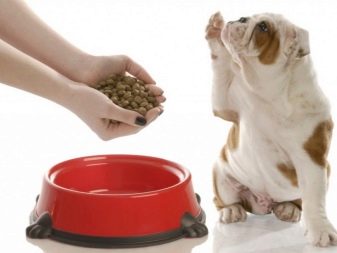
Observe all these requirements and features of the transfer of puppies and adult pets, and there will be no health problems for the pet.
For information on how to transfer a dog to dry food, see the next video.
